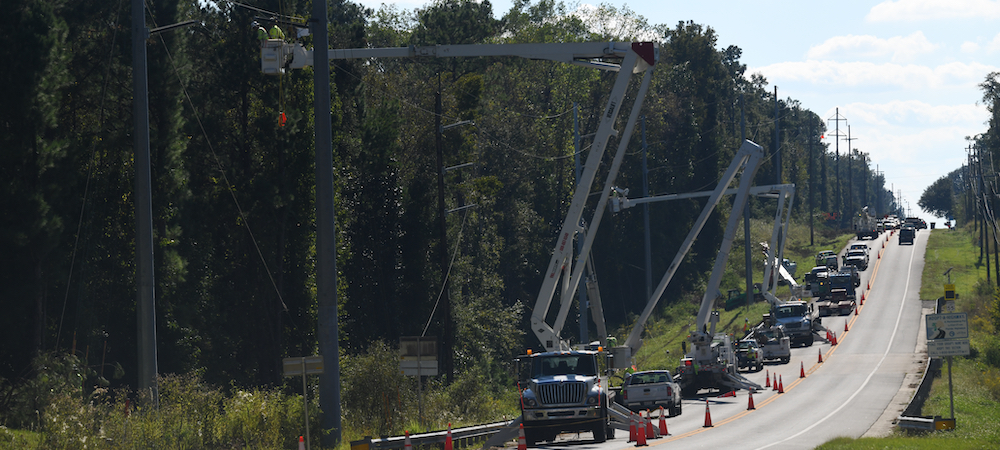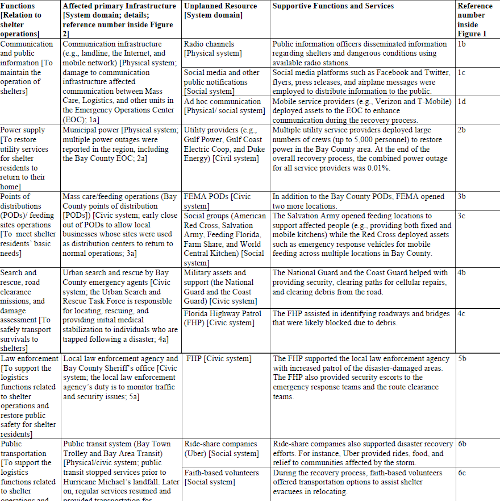 Multiple utility vehicles work to restore power after Hurricane Michael struck Florida. In some areas, outside utility workers came to repair power lines more quickly. ©Robert Blouin, 2017
Multiple utility vehicles work to restore power after Hurricane Michael struck Florida. In some areas, outside utility workers came to repair power lines more quickly. ©Robert Blouin, 2017
By Juyeong Choi, Eren Ozguven, and Tarek Abichou
Implications for Public Health
Nongovernmental organizations and local businesses can provide unplanned resources when shelters become overwhelmed. Shelters should consider including plans to leverage these additional resources in times of need.
During disasters, shelters provide essential services by distributing water, food, and other necessities and giving evacuees a safe place to stay until they can return to their homes. Government agencies often have detailed plans to ensure the success of these critical facilities. Recent disasters, however, have been so extreme that even well-planned shelters can easily be overwhelmed.
When shelter resources are exhausted, nongovernmental organizations (NGOs) and local businesses often step in to provide the extra supplies and labor required to meet community needs. As hazards grow frequent and intense, this is increasingly the case. Therefore, shelter planners might benefit not only from making accurate predictions of resources needed, but also by learning how to stretch their capacity when they face immense challenges. This can be done by harnessing the power of unplanned resources.
Imagine a Category 5 hurricane bearing down on a highly urbanized city. Because of the low probability but high impact of such an event, it’s not likely that the city’s shelters will be fully prepared to handle the disaster. The municipal utilities and public transport systems expected to support shelters could be disrupted and the capacity of local government agencies maxed out by the devastating impact of the storm. Further exacerbating the situation, the shelters are likely to experience a surge of people seeking safe spaces. In such a scenario, the planned resources—such as stockpiles of food and water, medical supplies, and fuel for generators— will run out quickly in the face of the high demand. In a rural context, resource shortages and lifeline infrastructure issues would potentially be even more severe due to supply chain disruptions or other challenges that can stem from geographic isolation.
We argue that what we refer to as “unplanned resources” may be mobilized in emergency scenarios and can help support shelter operations. These resources refer to supplies and assistance from NGOs, local businesses, and community volunteers that can extend the capacity of overstretched shelters. If cities or rural municipalities have a plan in place to call for and make use of such unplanned resources, it could mean the difference between successfully providing shelter or furthering the harm of the event.
Actively Engaging with Unplanned Resource Providers
Many researchers and government organizations recognize the importance of leveraging unplanned resources and have developed planning frameworks and guides to facilitate active engagement to support the use of both planned and unplanned resources in response and mitigation. In our work, for example, we have identified important players who help build resilience in seven infrastructure domains—civil, civic, social, cyber/communication, environmental, educational, and financial. Building on an earlier research framework, we identified entities within these seven domains that emerge to bolster the demand on shelters’ planned resources by providing unplanned resources. As such, it’s essential to encourage open communication and collaboration between infrastructure entities and shelters to ensure successful response and, ultimately, community resilience.
Consider, for example, that during Hurricane Michael in 2018, about 375,000 people in the Florida Panhandle evacuated their homes. Our research team investigated the operation of hurricane shelters in Bay County, Florida, and found that effective, timely coordination and collaboration between diverse entities was key for successful shelter management. Michael—a Category 5 hurricane—affected local water, electricity, wastewater, and road infrastructure and challenged hurricane shelter operations in the county. For instance, large-scale power outages impacted numerous other systems, causing one of the shelters to close after its wastewater disposal system was disrupted by lack of electricity.
Despite the devastating impact, local emergency agencies were able to successfully supply all shelter needs and close the shelters a month earlier than expected after finding long-term lodging solutions for shelter residents. Figure 1 shows the interplay between such entities on the timescale of Hurricane Michael. Specifically, it illustrates how the massive power outage in Bay County could have delayed the recovery of affected communities and threatened the operations of many shelters. This did not come to pass, however, because in addition to planned restoration efforts of municipal utility operators, more than 5,000 crew members from outside the county—an unplanned resource—were deployed to expedite power restoration for Bay County. Such previously uncommitted resources enabled shelter residents to return to their daily lives much quicker than expected based on the county’s restoration capacity.
Figure 1. Infrastructure Interplay Timescale Hurricane Michael Response and Recovery. Click Images to Enlarge.
Planning Ahead
Currently, many agencies lack empirical data—such as who was previously able to provide unplanned resources and what resources were available—to guide them in promoting the interplay between diverse entities to support shelters. Since entities such as NGOs and local businesses often don’t have formal commitments to provide localized assistance, it might be difficult to identify them in the planning stage.
Many hurricane-prone states, including Florida, South Carolina, and Virginia, activate shelters regularly and so have recognized the significance of these organizations and endeavored to engage them in disaster planning. That is, they’re trying to convert unplanned resources into planned resources. In order to tackle the lack of data, these states have established multiagency sheltering task forces that connect organizations that supported previous hurricane response efforts to federal, local, state, NGO, and private sector partners. The end goal is to ensure that shelter planning can be more effectively coordinated beyond the immediate response to preparation for future events.
As disasters increase in frequency and magnitude, typical planning methods might not sufficiently prepare shelters for future extreme events. With this in mind, we should focus more on ways to extend the planned resources for shelters when they are challenged. By cooperating and collaborating with emerging players who can supplement the capacity of affected infrastructure services, shelter planners can hope for the best and be prepared for the worst.
Suggested Tools
Shelter Field Guide
Federal Emergency Management Agency and American Red Cross
A guide that provides a basic overview of shelter operations to organizations without previous disaster experience that describes how to open and manage an emergency shelter during a disaster.
Multi-agency Sheltering/Sheltering Support Plan Template
Federal Emergency Management Agency and American Red Cross
A supplement for jurisdictional emergency operations plans or mass care annexes that provides guidance and suggested procedures to be considered when developing a sheltering plan. This template places an emphasis on jurisdictional roles in managing and supporting sheltering activities.
For a list of all the tools included in this special collection, visit the Mass Sheltering Tool Index. A list of further readings are also available.



Juyeong Choi is an assistant professor in the department of civil and environmental engineering at the Florida A&M University and the Florida State University College of Engineering. Choi’s master’s research developed a functional stress-strain framework to quantitatively understand the post-disaster operation of civil infrastructure, which he expanded with his doctoral work. Based on Choi’s interdisciplinary research, he has developed a decision support system for healthcare facilities that facilitates capacity-building planning for potential flood events.